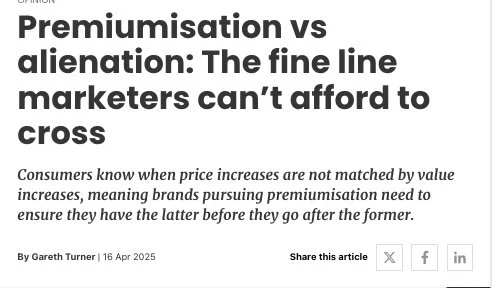SBR 56: Pricing strategy in FMCG: A guide
Pricing is a fundamental part of any marketing strategy, shaping how consumers perceive a brand and influencing sales, profitability, and market positioning. As one of the 4Ps of marketing (Product, Price, Place, and Promotion), pricing is not just about covering your costs, it’s a powerful tool for building brand equity and maximising profits. Gareth wrote an article for Marketing Week recently about premiumisation - this article breaks down how we go about it in more detail.
At Big Black Door, we help FMCG and food and drink brands develop data-driven pricing strategies, using techniques like the Van Westendorp Price Sensitivity Model to determine the optimal Recommended Selling Price (RSP).
NB: Whilst brands can influence their pricing, the prices are set at the sole discretion of the retailer. Our job is to show them ways that they can maximise their category value.
What is Marketing Pricing Strategy?
It’s the approach a brand takes to determine the best price for its products or services based on consumer perception, market competition , and business objectives. It plays a critical role in positioning a brand, driving sales, and ensuring profitability.
For the type of brands we work with, pricing strategy is critical because:
✅ Consumers make quick purchasing decisions based on perceived value.
✅ Pricing must align with and support your brand positioning, whether premium or mass-market.
✅ A robust pricing strategy helps avoid price wars, discount dependency, whilst maximising revenue potential.
The Role of Pricing in the 4Ps of Marketing
The 4Ps of marketing—Product, Price, Place, and Promotion—provide a foundation for a strong marketing strategy. Yet price is often seen as the least glamorous for marketers, and one which other departments (finance, sales) have a strong opinion. But that’s not to say marketers should be backing away from it. We’re the voice of the consumer in the business, and come with an important perspecive.
The Power of a Brand in Protecting Price Premium
A strong brand is one of the greatest assets in pricing strategy. Consumers are willing to pay more for brands that represent quality, trust, and emotional connection. Brand equity supports premium pricing in a number of ways:
✅ Perceived Value: A brand with strong storytelling and differentiation justifies higher prices.
✅ Loyalty & Advocacy: Brand fans are less price-sensitive and more likely to repurchase.
✅ Retail & E-commerce Advantage: Strong brands command better shelf positioning and DTC success.
✅ Reduced Need for Discounts: Price reductions erode brand value and profit/
Key Pricing methods in FMCG
Different pricing methods in marketing serve different brand objectives. Here are the most effective approaches:
1. Cost-Plus Pricing: A straightforward approach where a fixed margin is added to production costs.
✅ Ensures profitability
❌ Doesn’t account for consumer demand, competitor pricing or perceived value of your product so could may not maximise profitability
2. Competitive Pricing: Setting prices based on competitor benchmarks to stay competitive.
✅ Essential for highly saturated categories
❌ Can lead to price wars
3. Value-Based Pricing: Prices are determined by perceived consumer value, not just production costs.
✅ Works well for premium food and drink brands
❌ Requires strong brand equity. It’s how Weetabix (one of the brands I used to lead) can command such a significant premium vs own label wheat biscuits.
4. Penetration Pricing: A lower launch price to gain market share.
✅ Helps new brands enter competitive FMCG markets
❌ Risks devaluing brand perception from the start
5. Psychological Pricing: Using pricing tactics like £9.99 instead of £10 to drive impulse purchases.
✅ Encourages quick decision-making
❌ Less effective for premium brands and risks appearing “trixy” to consumers.
6. Premium Pricing: Setting prices above competitors to reinforce exclusivity and quality.
✅ Ideal for artisanal, organic, or specialty food products
❌ Requires strong brand storytelling and marketing support
FINDING the Right RSP FOR YOUR BRAND
Understanding the RSP is crucial for maximising revenue while maintaining brand perception. We use the Van Westendorp Price Sensitivity Meter to analyse consumer pricing perception. This model asks four key questions:
1. At what price would you consider this product too expensive?
2. At what price would you consider it too cheap (suggesting low quality)?
3. At what price would you consider it a bargain?
4. At what price would you consider it expensive but still worth it?
By analysing these responses, brands can determine an optimal price range that balances consumer expectations and profitability.
Why This Matters for FMCG Food & DRINK Brands
✅ Identifies the price point where customers perceive maximum value
✅ Prevents underpricing that devalues the brand
✅ Supports premium positioning by ensuring price aligns with brand equity
How We Help Brands FIND THEIR Pricing Strategies
• Using Data: Leveraging Van Westendorp analysis and competitor benchmarking.
• Brand Positioning & Pricing Alignment: Ensuring pricing reinforces premium brand status.
• Promotional & Discount Strategy – Planning a calendar of activity that that drives sales without relying solely on discounts that devalue the brand.
Need a Data-Driven Pricing Strategy?
For brands looking to protect their pricing power, it’s essential to build equity before discounting: strong brands command higher prices and set the benchmarks, rather than reacting to competitors. At Big Black Door, we help FMCG and food brands create pricing strategies that maximiSe profitability while protecting brand equity.
Get in touch today to refine your pricing strategy and maintain your competitive edge

